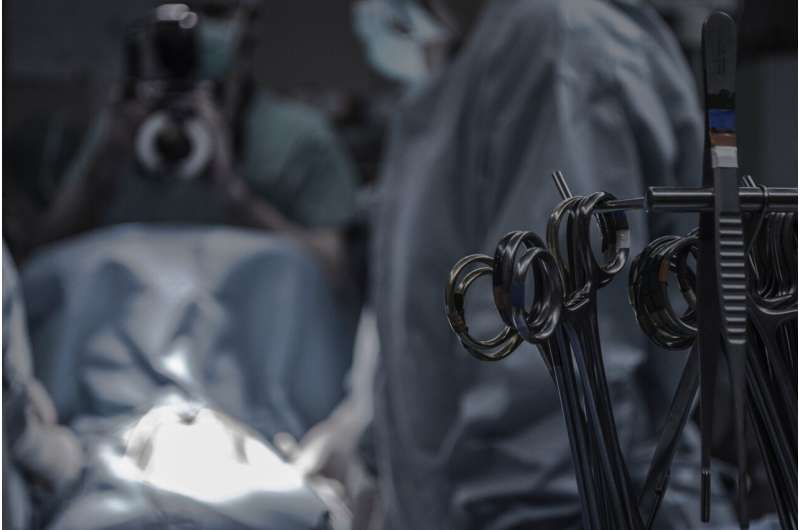This article has been reviewed according to Science X's editorial process and policies. Editors have highlighted the following attributes while ensuring the content's credibility:
fact-checked
peer-reviewed publication
trusted source
proofread
Intravascular imaging shown to significantly improve survival, safety and outcomes in stenting procedures

Using intravascular imaging to guide stent implantation during percutaneous coronary intervention (PCI) in heart disease patients significantly improves survival and reduces adverse cardiovascular events compared to angiography-guided PCI alone, the most commonly used method.
These are the results from the largest and most comprehensive clinical study of its kind comparing two types of intravascular imaging methods (intravascular ultrasound, or IVUS, and optical coherence tomography, or OCT) with angiography-guided PCI.
The study, published Wednesday, February 21, in The Lancet, is the first to show that these two methods of high-resolution imaging can reduce all-cause death, heart attacks, stent thrombosis, and the need for revascularization.
"Our study, representing a synthesis of all early and recent clinical studies, has shown for the first time that the routine use of intravascular imaging guidance improves survival and enhances all aspects of the safety and effectiveness of coronary stenting, even with excellent contemporary drug-eluting stents," says first author Gregg W. Stone, MD. Dr. Stone is Director of Academic Affairs for the Mount Sinai Health System, and Professor of Medicine (Cardiology), and Population Health Science and Policy, at the Icahn School of Medicine at Mount Sinai.
"Prior studies had shown benefits of intravascular imaging, but never to this extent," Dr. Stone adds. "The addition of four recent trials in which 7,224 patients were enrolled now shows that intravascular imaging reduces all-cause death and all heart attacks across the wide range of patients who undergo stent treatment.
"As such, the routine use of intravascular imaging to guide stent implantation is one of the most effective therapies we have to improve the prognosis of patients with coronary artery disease."
Patients with coronary artery disease—plaque buildup inside the arteries that leads to chest pain, shortness of breath, and heart attack—often undergo PCI, a non-surgical procedure in which interventional cardiologists use a catheter to place stents in the blocked coronary arteries to restore blood flow.
Interventional cardiologists most commonly use angiography to guide PCI, which involves a special dye (contrast material) and X-rays to see how blood flows through the heart arteries to highlight any blockages.
Angiography has limitations, however, making it difficult to determine the true artery size and the makeup of the plaque, and is suboptimal in identifying whether the stent is fully expanded post-PCI and in detecting other conditions that affect the early and late outcomes of the procedure.
Intravascular ultrasound was introduced more than 30 years ago to provide a more accurate and specific picture of the coronary arteries. Even though studies have shown that IVUS-guided PCI is superior to angiography-guided PCI and reduces cardiovascular events, it is only used in roughly 15% to 20% of PCI cases in the United States, since the images may be difficult to interpret and the procedure is not fully reimbursed.
Optical coherence tomography uses light instead of sound to create images of the blockages. OCT images are much higher in resolution, more accurate, and more detailed compared to IVUS, and easier to interpret. However, as a newer technique, OCT is used in only 3% of PCI cases, partly because of a lack of study data—a limitation this new study has addressed.
In their study, the researchers analyzed data from 15,964 patients undergoing PCI from 22 trials in hundreds of centers from the United States, Europe, Asia, and elsewhere between March 2010 and August 2023. Patients underwent either angiography-guided PCI or intravascular imaging-guided PCI using either IVUS or OCT.
During follow-up ranging from 6–60 months with a mean of two years, patients who received intravascular imaging guidance experienced a 25% reduction in all-cause death, 45% reduction in cardiac death, 17% reduction in all myocardial infarctions, and 48% reduction in stent thrombosis compared with angiography guidance.
The study also found that intravascular imaging reduced target vessel myocardial infarction by 18% and target lesion revascularization by 28%. The outcomes were similar for OCT-guided and IVUS-guided PCI.
"With these results, we now need to shift from performing more studies to determine whether intravascular imaging is beneficial, to increasing efforts to overcome the remaining impediments to the routine use of OCT and IVUS, including better training of physicians and staff and increasing reimbursement," Dr. Stone said.
"In this regard, we now have better 'hard evidence' that intravascular imaging guidance of PCI procedures makes a greater impact to improving our patients' lives than other routine therapies which are more widely used and reimbursed."
More information: Intravascular imaging-guided coronary drug-eluting stent implantation: an updated network meta-analysis, The Lancet (2024).




















